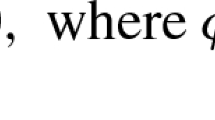Abstract
We discuss a certain special subset of Lagrange multipliers, called critical, which usually exist when multipliers associated to a given solution are not unique. This kind of multipliers appear to be important for a number of reasons, some understood better, some (currently) not fully. What is clear, is that Newton and Newton-related methods have an amazingly strong tendency to generate sequences with dual components converging to critical multipliers. This is quite striking because, typically, the set of critical multipliers is “thin” (the set of noncritical ones is relatively open and dense, meaning that its closure is the whole set). Apart from mathematical curiosity to understand the phenomenon for something as classical as the Newton method, the attraction to critical multipliers is relevant computationally. This is because convergence to such multipliers is the reason for slow convergence of the Newton method in degenerate cases, as convergence to noncritical limits (if it were to happen) would have given the superlinear rate. Moreover, the attraction phenomenon shows up not only for the basic Newton method, but also for other related techniques (for example, quasi-Newton, and the linearly constrained augmented Lagrangian method). Despite clear computational evidence, proving that convergence to a critical limit must occur appears to be a challenge, at least for general problems. We outline the partial results obtained up to now. We also discuss the important role that noncritical multipliers play for stability, sensitivity, and error bounds. Finally, an important issue is dual stabilization, i.e., techniques to avoid moving along the multiplier set towards a critical one (since it leads to slow convergence). We discuss the algorithms that do the job locally, i.e., when initialized close enough to a noncritical multiplier, their dual behavior is as desired. These include the stabilized sequential quadratic programming method and the augmented Lagrangian algorithm. However, when the starting point is far, even those algorithms do not appear to provide fully satisfactory remedies. We discuss the challenges with constructing good algorithms for the degenerate case, which have to incorporate dual stabilization for fast local convergence, at an acceptable computational cost, and also be globally efficient.









Similar content being viewed by others
References
Andreani R, Birgin EG, Martínez JM, Schuverdt ML (2007) On augmented Lagrangian methods with general lower-level constraints. SIAM J Optim 18:1286–1309
Andreani R, Birgin EG, Martínez JM, Schuverdt ML (2008) Augmented Lagrangian methods under the constant positive linear dependence constraint qualification. Math Program 111:5–32
Andreani R, Haeser G, Schuverdt ML, Silva PJS (2012) A relaxed constant positive linear dependence constraint qualification and applications. Math Program 135:255–273
Bertsekas DP (1982) Constrained optimization and Lagrange multiplier methods. Academic Press, New York
Birgin EG, Martínez JM (2008) Improving ultimate convergence of an augmented Lagrangian method. Optim Methods Softw 23:177–195
Birgin EG, Martínez JM (2014) Practical augmented Lagrangian methods for constrained optimization. SIAM, Philadelphia
Di Pillo G, Grippo L (1979) A new class of augmented Lagrangians in nonlinear programming. SIAM J Control Optim 17:618–628
Fernández D, Pilotta EA, Torres GA (2013) An inexact restoration strategy for the globalization of the sSQP method. Comput Optim Appl 54:595–617
Fernández D, Izmailov AF, Solodov MV (2010) Sharp primal superlinear convergence results for some Newtonian methods for constrained optimization. SIAM J Optim 20:3312–3334
Fernández D, Solodov M (2010) Stabilized sequential quadratic programming for optimization and a stabilized Newton-type method for variational problems. Math Program 125:47–73
Fernández D, Solodov M (2012) Local convergence of exact and inexact augmented Lagrangian methods under the second-order sufficient optimality condition. SIAM J Optim 22:384–407
Fischer A (2002) Local behavior of an iterative framework for generalized equations with nonisolated solutions. Math Program 94:91–124
Friedlander MP, Saunders MA (2005) A globally convergent linearly constrained Lagrangian method for nonlinear optimization. SIAM J Optim 15:863–897
Gill PE, Murray W, Saunders MA (2002) SNOPT: An SQP algorithm for large-scale constrained optimization. SIAM J Optim 12:979–1006
Gill PE, Robinson DP (2012) A primal–dual augmented Lagrangian. Comput Optim Appl 51:1–25
Gill PE, Robinson DP (2013) A globally convergent stabilized SQP method. SIAM J Optim 23:1983–2010
Glad ST (1979) Properties of updating methods for the multipliers in augmented Lagrangian. J Optim Theory Appl 28:135–156
Golubitsky M, Schaeffer DG (1985) Singularities and groups in bifurcation theory, vol 1. Springer, New York, Berlin, Heidelberg
Hager WW (1999) Stabilized sequential quadratic programming. Comput Optim Appl 12:253–273
Hager WW, Gowda MS (1999) Stability in the presence of degeneracy and error estimation. Math Program 85:181–192
Hestenes MR (1969) Multiplier and gradient methods. J Optim Theory Appl 4:303–320
Izmailov AF (2005) On the analytical and numerical stability of critical Lagrange multipliers. Comput Math Math Phys 45:930–946
Izmailov AF (2011) On the limiting properties of dual trajectories in the Lagrange multipliers method. Comput Math Math Phys 51:3–23
Izmailov AF (2010) Solution sensitivity for Karush-Kuhn-Tucker systems with nonunique Lagrange multipliers. Optimization 59:747–775
Izmailov AF, Krylova AM, Uskov EI (2011) Hybrid globalization of stabilized sequential quadratic programming method. In Russian. In: Bereznyov VA (ed) Theoretical and applied problems of nonlinear analysis. Computing Center RAS, Moscow, pp 47–66
Izmailov AF, Kurennoy AS (2013) Abstract Newtonian frameworks and their applications. SIAM J Optim 23:2369–2396
Izmailov AF, Kurennoy AS, Solodov MV (2013a) A note on upper Lipschitz stability, error bounds, and critical multipliers for Lipschitz-continuous KKT systems. Math Program 142:591–604
Izmailov AF, Kurennoy AS, Solodov MV (2013b) Local convergence of the method of multipliers for variational and optimization problems under the noncriticality assumption. Comput Optim Appl 60:111–140
Izmailov AF, Solodov MV (2009a) Examples of dual behaviour of Newton-type methods on optimization problems with degenerate constraints. Comput Optim Appl 42:231–264
Izmailov AF, Solodov MV (2009b) On attraction of Newton-type iterates to multipliers violating second-order sufficiency conditions. Math Program 117:271–304
Izmailov AF, Solodov MV (2011) On attraction of linearly constrained Lagrangian methods and of stabilized and quasi-Newton SQP methods to critical multipliers. Math Program 126:231–257
Izmailov AF, Solodov MV (2012) Stabilized SQP revisited. Math Program 122:93–120
Izmailov AF, Solodov MV (2014) Newton-type methods for optimization and variational problems. Springer Series in Operations Research and Financial Engineering
Izmailov AF, Solodov MV (2015) Newton-type methods: a broader view. J Optim Theory Appl 164:577–620
Izmailov AF, Solodov MV, Uskov EI (2012) Global convergence of augmented Lagrangian methods applied to optimization problems with degenerate constraints, including problems with complementarity constraints. SIAM J Optim 22:1579–1606
Izmailov AF, Solodov MV, Uskov EI (2014a) Globalizing stabilized SQP by smooth primal–dual exact penalty function. IMPA preprint A752/2014, Rio de Janero
Izmailov AF, Solodov MV, Uskov EI (2014b) Combining stabilized SQP with the augmented Lagrangian algorithm. IMPA preprint A754/2014, Rio de Janero
Izmailov AF, Uskov EI (2014) Attraction of Newton method to critical Lagrange multipliers: fully quadratic case. Math Program. doi:10.1007/s10107-014-0777-x
Izmailov AF, Uskov EI (2012a) On the influence of the critical Lagrange multipliers on the convergence rate of the multiplier method. Comput Math Math Phys 52:1504–1519
Izmailov AF, Uskov EI (2012b) The effect of attraction of the Newton–Lagrange method to critical Lagrange multipliers: full analysis in the one-dimensional case. In Russian. In: Bereznyov VA (ed) Theoretical and applied problems of nonlinear analysis. Computing Center RAS, Moscow, pp 53–71
Li DH, Qi L (2000) Stabilized SQP method via linear equations. Applied Mathematics Technical Report AMR00/5. University of New South Wales, Sydney
Martínez JM, Pilotta EA (2000) Inexact restoration algorithms for constrained optimization. J Optim Theory Appl 104:135–163
Martínez JM, Pilotta EA (2005) Inexact restoration methods for nonlinear programming: advances and perspectives. Optimization and control with applications. Springer, New York, pp 271–292
Murtagh BA, Saunders MA (1982) A projected Lagrangian algorithm and its implementation for sparse nonlinear constraints. Math Program Study 16:84–117
Murtagh BA, Saunders MA (1983) MINOS 5.0 user’s guide. Technical Report SOL 83.20, Stanford University
Powell MJD (1969) A method for nonlinear constraints in minimization problems. In: Fletcher R (ed) Optimization. Academic Press, New York, pp 283–298
Robinson SM (1972) A quadratically convergent algorithm for general nonlinear programming problems. Math Program 3:145–156
Solodov MV (2010) Constraint qualifications. In: Cochran JJ (ed) Wiley encyclopedia of operations research and management science. Wiley
Uskov EI (2013) On the attraction of Newton method to critical Lagrange multipliers. Comp Math Math Phys 53:1099–1112
Wright SJ (1998) Superlinear convergence of a stabilized SQP method to a degenerate solution. Comput Optim Appl 11:253–275
Author information
Authors and Affiliations
Corresponding author
Additional information
This invited paper is discussed in the comments available at doi:10.1007/s11750-015-0368-x, doi:10.1007/s11750-015-0369-9, doi:10.1007/s11750-015-0370-3, doi:10.1007/s11750-015-0371-2.
Research of the first author is supported by the Russian Foundation for Basic Research Grant 14-01-00113 and by CNPq Grant PVE 401119/2014-9 (Brazil). The second author is supported in part by CNPq Grant 302637/2011-7, by PRONEX–Optimization, and by FAPERJ.
Rights and permissions
About this article
Cite this article
Izmailov, A.F., Solodov, M.V. Critical Lagrange multipliers: what we currently know about them, how they spoil our lives, and what we can do about it. TOP 23, 1–26 (2015). https://doi.org/10.1007/s11750-015-0372-1
Published:
Issue Date:
DOI: https://doi.org/10.1007/s11750-015-0372-1
Keywords
- Critical Lagrange multipliers
- Second-order sufficiency
- Newton-type methods
- Sequential quadratic programming
- Newton–Lagrange method
- Superlinear convergence




